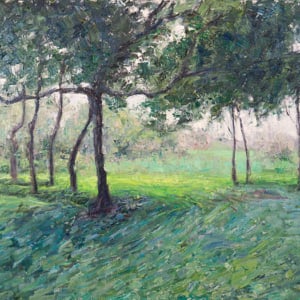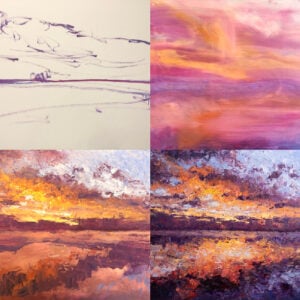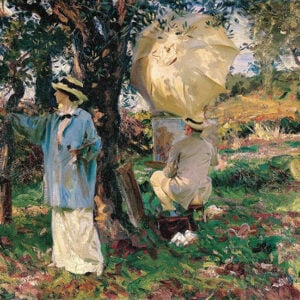- Other Examples of Chaos and Harmony in Art
- Key Takeaways
- Additional Resources
- Want to Learn More?
- Thanks for Reading!
Below are two recent but vastly different paintings based on the jetty at Kingfisher Bay. Together, they remind me of chaos and harmony.

So much of art can be distilled down to a basic conflict between chaos and harmony.
Chaos is unexpected, unwanted, unknown. It’s that burst of activity amongst a quiet background. It’s your mistakes. It’s dropping the canvas on the floor. It’s the subject moving whilst you’re painting.
Harmony is connection, expectation, pattern, repetition, relationships. It’s when everything works together. It’s the blues, greens, and purples in Claude Monet’s water lilies series. It’s when you place the right color in the right place (credit to Richard Schmid for writing something along these lines).
Fraser Island, Drama (below) leans towards chaos, especially compared to its subtle counterpart. It captures the vibrant sunset from the end of the jetty. It’s a battle of light against gritty darkness, warm against cool.
Chaos in this case is the rough brushwork and palette knife strokes; the vague jetty; the turbulent water.
Harmony is the relationship between warm and cool; the balance between sky and sea; the repetition and structure of the jetty; the patterns created by the sky and clouds.

Fraser Island, High Key leans towards harmony. It captures blue hour and it’s wonderful pastel colors.
But make no mistake, there’s chaos in this painting. Just as there’s harmony in Fraser Island, Drama. Notice the dark blue accents; the gloomy clouds in the distance; the irregular jetty posts and lights; the ambiguous figures.

It’s important to note that chaos and harmony need each other. Chaos without harmony is meaningless. Harmony without chaos is boring; it’s a blank canvas.
I like to think of them on a scale, rather than as absolutes. Does my painting lean towards chaos or harmony? This way of thinking invites the use of both chaos and harmony, not one or the other.
James Whistler suggests in the following quote that chaos is the baseline and it’s up to artists to bring forth glorious harmony. How much harmony is up to you.
Nature contains the elements, in colour and form, of all pictures, as the keyboard contains the notes of all music. But the artist is born to pick and choose… that the result may be beautiful – as the musician gathers his notes, and forms his chords, until he brings forth from chaos glorious harmony…” James Abbott McNeill Whistler
Other Examples of Chaos and Harmony in Art
Let’s run through some other examples, starting with Joseph Turner’s Rain, Steam and Speed – The Great Western Railway.
Chaos is:
- The battle between the stygian black train and nature’s foggy atmosphere.
- The vague background.
- The energetic brushwork and scumbled color.
Harmony is:
- The dull color palette.
- The sense of movement.
- The balance between large ambient space and small dark accents.
- The relationship between warm and cool colors.

Here’s another painting by Turner.
Chaos is:
- Fighting and death.
- The damaged ships.
- The booming clouds.
Harmony is:
- The ships’ beautiful engineering, repetition, and pattern.
- People working together (even if it is against other people).
- The flags representing a common cause or identity.

Lilla Cabot Perry’s Cliffs of Etretat.
Chaos is:
- The crashing waves and whitewater.
- The battle between sea and land.
- The bright clouds that break up the blue sky.
Harmony is:
- The blues, greens, and purples.
- The oranges and reds.
- The sense of movement in the sky and sea.
- The immovable force of the land.

Peder Krøyer’s From Burmeister and Wain’s Iron Foundry.
Chaos is:
- The untamed power of fire and heat.
- The potential accidents and mistakes that might have dire consequences.
- The imperfect nature of humans.
Harmony is:
- People working together.
- The scaffolding above.
- The science, engineering, and progress.

Pierre Auguste Renoir’s Pont Neuf.
Chaos is:
- The ambiguous nature of the figures.
- The activity on the streets, with cars, horses, adults, and children all occupying the same area.
Harmony is:
- The flag hanging on the right.
- The pleasant arrangement of clouds.
- The repetition and pattern of the architecture.
- The balance between sky and land.

Chaos is:
- The energetic strokes.
- The troubled and creative mind of its creator.
- The unusual shapes and lines.
Harmony is:
- The sense of repetition.
- The color groupings.
- The consistent style.

In my recent Tree, Dappled Light, chaos is:
- The streaky colors that represent the dappled light. There’s a wonderful element of uncertainty when I pick up two or three colors on a brush and make a stroke on the canvas.
- The branches shooting out at all directions.
- The wild brushwork.
Harmony is:
- The light oranges and greens.
- Nature’s subtle patterns.
- The solidarity of the tree trunk.
- The sense of connection. The leaves, branches, trunks, plants, and grass all grow from the same soil.

Key Takeaways
- You need both chaos and harmony. They are meaningless without each other.
- Think of chaos and harmony on a scale, rather than absolutes. Does your painting lean towards chaos or harmony? This way of thinking invites you to use both, not one or the other.
- Context matters. My Fraser Island, High Key represents harmony when compared to Fraser Island, Drama. But by itself, it’s a story of both chaos and harmony.
Additional Resources
- Principles of Art
- A Closer Look at Claude Monet’s Waterloo Bridge Series – Paintings that lean towards harmony.
- What You Can Learn from These 10 Dramatic Paintings – Paintings that lean towards chaos.
- Jordan Peterson’s 12 Rules for Life: An Antidote to Chaos – Not related to painting but has some interesting takes on chaos and harmony in life.
- On the Easel: Fraser Island, High Key, September 2020
- Painting Academy – My fundamentals course.
Want to Learn More?
You might be interested in my Painting Academy course. I’ll walk you through the time-tested fundamentals of painting. It’s perfect for absolute beginner to intermediate painters.
Thanks for Reading!
I appreciate you taking the time to read this post and I hope you found it helpful. Feel free to share it with friends.
Happy painting!
Dan Scott

Draw Paint Academy
About | Supply List | Featured Posts | Products
Draw Paint Academy







Excellent all round. Thank you so much for these insights.
I am a self taught water color enthusiast after only using acrylics. You have really helped me understand more about art than I could ever say. You are a great teacher and thank you.
Thanks for the inspiration
You’re just the best. Always get something KEY after 15 years – even as a professional artist. Thank you
I am getting so much from your posts and look forward to them. Not only are you a good artist but you are a born teacher. I am in your Master Landscape course which is helping me immensely.
Just thank you! Thank you for teaching me to look at art in new ways. I appreciate the examples you add in the emails.
Found your tutorials and general articles on art very inspiring and motivating. Thanks for this fantastic exposure…
As a psychologist, I have studied aesthetics (people’s visual preferences). Your post on chaos and harmony fits in with my findings and those of other researchers. It goes back to an old quote that the essence of beauty is “unity in variety.” Scientific studies confirm that people prefer ordered disorder, that is complexity, variety, novelty, etc. in a unified, ordered, coherent, or organized structure. The disorderly elements catch our attention and increase arousal. The organization helps us make sense of the disorder, lowering arousal and uncertainty. Too much disorder overloads our senses and lowers preference. Too little disorder looks boring. People tend to prefer a mid-level mix of disorder and order.
Interesting, I appreciate these comments. Dan’s post are fantastic and for the first time I struggled to identify with all points being made (normally they point to things we can agree on if we think around the subject).
So: a stormy sea is chaotic, naturally.
Why is Turner’s steam train harmonious? It disturbs the scene and signals modern technology, surely?
Anyway, thanks both ! Food for thought.
Great insights and very effective guidelines for self-critique!
Thank you!
Thank you for the content and lovely insights. Incredible paintings also! I often see more content based on studies, which are important but only grasp the greater universe of the whole composition, color and brushwork relations of a “finished” painting. Thanks Again!
Thanks so much Dan. Your seaside paintings to example chaos and harmony are fabulous.
Fantastic article, Thanks Dan. Your emails are wonderful.
This is the first post I’ve read and its really helpful and tomorrow I will get all my chaotic beginnings out and prganise myself to add the harmony.
Thank you
It’s always helpful to find A different way of thinking about why a painting works visually. Your email makes clear the reason why harmony and chaos are co- dependent and both necessary to make a visually and psychologically satisfying painting. And you offer techniques for using both. Thank you so much!
Thanks for giving me something else to consider to help make my paintings interesting and viewer worthy!
Such a fine and important content added to the previous valuable teaching material! How to handle chaos and harmony will give me new opportunities for improving my painting!
An Education. Thank you
Couldn’t agree more with you Dan. Chaos and Harmony goes hand in hand.
Dan thanks for such an explanation of harmony and chaos .very insightful. Thanks for broadening my perspective.
Looking forward to hear from you again.
Thanks once again.
Thank you for all this inspiration, have learned a lot on chaos and harmony, you are amazing!!
I enjoyed the journey through chaos and harmony. Balance is so vital and your story highlights all the good in having both qualities in a painting. Thank you so much.
You are so generous with your information, a selfless teacher. Thank you Dan for the effort you put in to these articles, much appreciated.
Thank you Dan for sharing such wisdom and inspiration.
I think I have not ever thought about chaos/harmony together in a painting. I have to think more about this and my personal work/painting. Thank you for these insights, though. My immediate thought is a painting I did this month with a palette knife only. I can see chaos and harmony in this painting. However, now I want to look back and see if I have more chaos in my works. I know I have some harmony, but hoping I also have chaos.
Thanks for sharing your knowledge. We learn something new every day. Greetings!